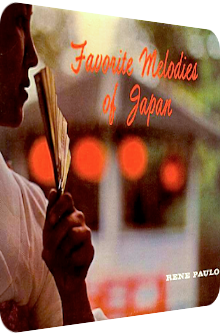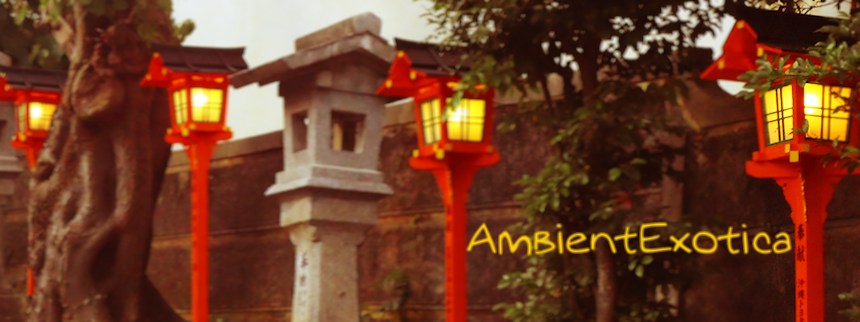
Rene Paulo
Favorite Melodies
Of Japan
1963
Favorite Melodies Of Japan is a piano-driven album comprising of twelve tracks by the Rene Paulo Trio, originally released in 1963 on Mahalo Records and digitally reissued in 2012. Bandleader and pianist Rene Paulo (born 1930) is accompanied by drummer Bruce Hamada and guitarist Tomo Fukui, although Hamada’s drums are completely amiss and replaced by cymbals and hi-hats. Favorite Melodies Of Japan is released during a time when the interest in Japanese melodies slowly waned, having had its peak during the late 50’s and early 60’s. Notwithstanding this chronicle, Rene Paulo’s album is a welcome addition to the roster of like-minded artists such as conductor Werner Müller’s Holidays In Japan (1958), The Tokyo Serenaders’ same-titled album of the late 50’s, organist Paul Mark’s 12½ Geishas Must Be Right (1963) as well as Percy Faith's Koga Melodies (1970), among multitudinous others, sharing many a melody and composition with these artifacts.
Rene Paulo’s album, however, is basically stripped to the bones. Whereas other Japan-inspired albums feature cornucopias of strings, exotic percussion, kotos plus shamisens as well as Space-Age organs, Favorite Melodies Of Japan continues Paulo’s serious and dedicated Jazz approach which he kicked off with his debut Black Coral (1960). He remains completely in the limelight, the accompaniments are deliberately sparse and only rarely revved up in terms of their voluminosity or quantity with the help of archetypically Japanese claves, for instance. The arrangements are still exotic enough, their melodies probably carved out better than anywhere else, for what the album lacks in textures, it delivers in essence, stringency and satori. This is of course not the best approach in the flamboyant world of gleeful Exotica, but there is enchantment to be found in here.
The first doubt of whether this is a true Exotica album or not is already raised by the initial piano chords of Namida No Wataridori, translatable as “bird of tears”. This is indeed one of the more doleful Japanese Folk songs to begin with, but the cloudy mood improves immediately. Rene Paulo’s performance on the piano becomes more liquedous and moist, lightens up with sunbursts, is carefully accentuated by Tomo Fukui’s acoustic guitar scents… and cross-fades into the classic Wakare No Isochidori, also known as The Lonely Seabird or Misty Sea. Here’s the twist: it features the same melodic structure and could be seen as a rework or addendum to the opener. A song about a woman who only reveals the sorrow – her husband being at sea far away from her – to the seabirds, it is known for its lachrymose gentleness and hopeful spirit. Rene Paulo focuses decidedly on the tones in major; they shimmer in golden colors, a breeze of sizzling maracas as well as infinitesimal ukulele globs are ennobling the solemnity of this piece. To be honest, Paulo’s take is almost too sun-soaked and carefree for my taste, but it lives up to the jazzier and insouciant side of Exotica.
However, Kojo No Tsuki is the real highlight of the album. It is getting dark immediately. Best known to Occidental ears in the shape of Arthur Lyman’s take and translated as Moon Over A Ruined Castle on the album Bwana Ā (1959), Paulo’s version is strikingly luring as well, inducing a moonlit forsaken aura via his yearning, archetypically Japanese piano spirals and pale staccato. The acoustic guitar twangs illumine the ashen luminosity further, mimicking the foreign timbre of a koto. Neither all to crestfallen nor desiccating its mystique, Paulo really understands the nucleus of this traditional composition, with his arrangement somehow implying more instruments and a greater density than it can physically inherit. It is magic.
Tamezo Narita’s Hamabe No Uta is next, otherwise known as Song Of The Seashore or Surftides. This is once again a strikingly uplifting tune, very majestic and more akin to a clear cut piano arrangement than an performance by a trio. Only Bruce Hamada’s silkened maracas underline the vigorous-voluminous piano cascades which imply a warm summer day at the titular seashore. There are not too many textures or effervescent styles injected, so the listener either loves this rendition for its strong melodies or not. Tabi No Yokaze (translatable as Night Winds) is another take on the Japanese formula of mystery and longing. Some of Paulo’s chords sound astonishingly Latinized, as the timbre and hot-blooded lust are occasionally appearing here as well. Best of all is a careful and almost inaudible accompaniment on the guitar. The plucked strings are eminently sanguine and soft, adding another meaning and tonality to Tabi No Yokaze.
Side A closes with Soshu Yakyoku (Tears), and it is a disappointing piece, at least from my specific Exotica-driven viewpoint. Even though Paulo interprets it faithfully, the melody is simply too Occidental to be considered exotic. Bruce Hamada’s gaseous cymbal scents are not allowed to break free and rather accompany Paulo’s performance in an adamantly streamlined form.
Hana Kotoba No Uta kicks off side B, a song about blooming flowers. Its signature element is found in the backing droplets which seem to resemble the sounds of electric pianos, but these only occurred much later in Rene Paulo’s arrangements. So it has to be a special nylon string guitar by Tomo Fukui, I presume. Whatever its origin, the surface sparkles and glints in mid-frequency ranges and ameliorates the otherwise less memorable sequence of warm chords. While the chintzy midtempo ballas Mashiroki Fuji No Ne, the Sea Of Tears, oscillates between strongly benign and lesser threnodic moods, the interpretation of the Exotica classic Ringo Oiwake is a superb success thanks to Bruce Hamada’s clicking claves and their enigmatic echo, the magnificently mystical pentatonic mélange on Paulo’s piano which shuttles between loftiness and opaqueness, and last but not least Tomo Fukui’s dark guitar twangs which form a counterpoint to the piercing hi-hats in the middle section. The bone-crushing piano oomph rounds off the greatest piece of Exotica on this album which lives up to the Japanese flavor that is so desired. An absolutely stellar take!
The following De Bune is also known as Lullaby Of The Waves and turns out to be the first – and only – exclusive piano arrangement on the album, a trait it shares with Paulo’s previous and succeeding LP’s where at least one tune is always reserved for his prestidigitation alone. Almost Latin in its appearance, De Bune surprises with a slowly rising chord progression whose aura grows (or glows?) stronger with each subsequent chord. This noticeable effect is only applied to the prelude and final phase, as the main body comprises of sorrowful billows and swift glissando keys. It is all in all a great and captivating tune, even though I am usually wary of exotic piano arrangements, given the strong expression and wealth of instruments the Exotica genre spawns time and again.
Su-Ite Ita No Ni or Beyond Happiness opens the strict formula once more – and again only in the prelude and sunset sequence – with music box-like fairy tale glockenspiels. The following, specifically punchy-aqueous piano prongs and the simply delicate melancholia make this another contemplative piece I come back to very often, despite the gimmicky and non-essential appearance of the iridescent glitters. The traditional Sakura closes the album. One of the best-known and oft-interpreted Japanese songs in vintage Exotica albums, the already starkly distant and very dark physiognomy is even augmented by Rene Paulo. Sakura appears as a heavyweight closer with several rhythm shifts. Incredibly dun and staggering piano chords are followed by a vesiculating melodramatic arpeggio. A great, unbelievably gloomy closer whose edges are rounded off by Bruce Hamada’s cymbal waves and only outshone in by Paul Mark's Sakura Medley off East To West (1961).
Fans of the late Martin Denny – who returned to his true profession as a pianist – as well as insiders of Japanese Folk songs and traditional compositions will get the most out of Rene Paulo’s Favorite Melodies Of Japan. For novices, the album certainly lacks the wideness and textural magnitude, the scope is purposefully narrowed down, Paulo and his piano remain in the limelight all the time, a characteristic trait that traverses through the majority of his 60’s albums. This sort of minimalism is not what the typical Exotica aficionado has in mind, not even the occasional listener who wants to be entertained. Those who know a few of these compositions by heart, though, will surely be more than a bit satisfied with Paulo’s reductionist trademark sound.
I for one adore the two-part opener Wataridori/Isochidori, the exquisite take on Ringo Oiwake as well as the successful renditions of the ever-dark Sakura and the arcane Kojo No Tsuki aka Moon Over A Ruined Castle. Probably not entirely coincidentally, these are also the takes that are scattered over many Exotica classics, so even those listeners who basically narrow down the genre of Exotica to Martin Denny and Arthur Lyman only will encounter the melodies and might suddenly remember them. That the track titles appear in Japanese does not help the memorization process, but at least the 2012 reissue provides English translations. Favorite Melodies Of Japan is definitely not the best choice as a gateway to Japanese Exotica, but serves as an aesthetically pleasing appendix for those listeners who cannot get enough of an oxymoronically modern vintage take of these classics.
Exotica Review 278: Rene Paulo – Favorite Melodies Of Japan (1963). Originally published on Nov. 2, 2013 at AmbientExotica.com.
